Story
Meet Bryony, our Phytoplankton apprentice
14 February 2025
It’s National Apprenticeship Week! And what better way to celebrate than finding out more about our Phytoplankton Apprentice, Bryony Pearton, and her work to improve our understanding of mysterious microscopic plankton.

Bryony, a Marine Biology and Coastal Ecology graduate from the University of Plymouth, joined us last year in the brand-new role of Phytoplankton Apprentice.
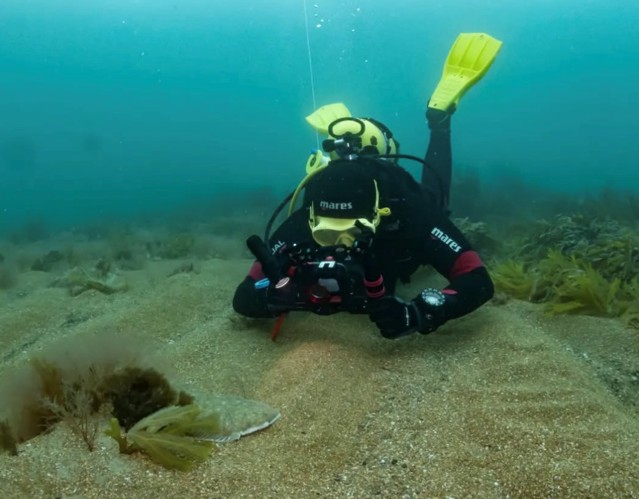
Image above: In her spare time, Bryony enjoys Scuba Diving, she is pictured here photographing a sole fish. Bryony says “I am completely fascinated by the tiniest parts of our marine environment”.
Phytoplankton may be small, but their importance cannot be understated when it comes to the health of our ocean. These tiny autotrophic, mixotrophic and heterotrophic species play a crucial role in supporting the majority of marine ecosystems and ultimately the human communities that depend on them.
And, as some are plant-like organisms, they contain chlorophyll to capture sunlight, and use photosynthesis to turn it into chemical energy. Through this process, phytoplankton absorb carbon dioxide, and release oxygen – and play a huge role in the marine carbon cycle. It is estimated 50% of the world’s oxygen is produced in the ocean, and the majority produced by phytoplankton. In addition, phytoplankton form the base of marine food webs, providing essential food for a huge size range of other marine life, from plankton through to whales.
Bryony’s role as Phytoplankton apprentice has seen her join the L4 plankton time series team, and to become trained in all areas; from collecting samples out on our research vessel Plymouth Quest, to learning how to analyse samples, data dissemination, and training on exciting new technology.
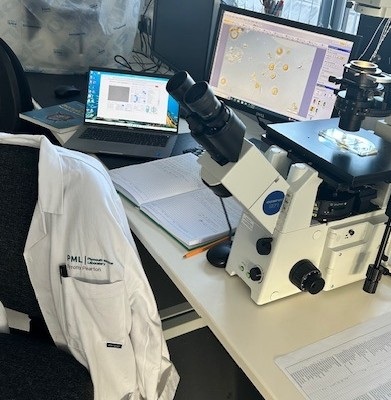
Image above: Bryony’s microscope workstation for analysing phytoplankton net samples in the lab.
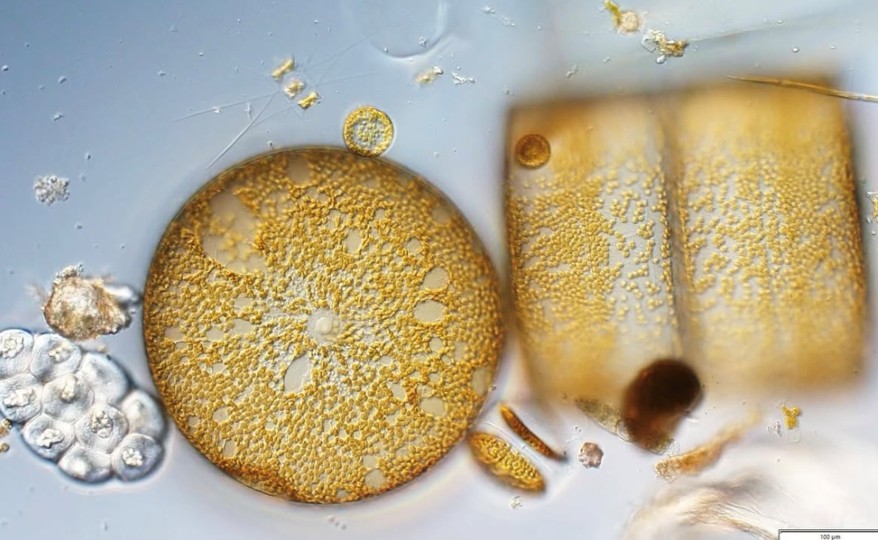
Image above: Under the microscope, Bryony identifies the large diatom Coscinodiscus wailesii. Diatoms are unicellular, photosynthetic phytoplankton whose bodies are made up of silica, or glass. This sample was taken about 6 nautical miles from Plymouth and brought into the laboratory for analysis. Image credit: Bryony Pearton
Bryony describes her motivation to join the laboratory in this role.
“To be completely honest, since studying marine biology at university, and being a generally fish-obsessed child and then adult, I had been very aware of PML’s research for a long time. As a result I really aspired to work here.”
“The apprenticeship offered me a unique opportunity to learn on the job from some really brilliant scientists. I have always found phytoplankton fascinating; they live such complex and interesting lives. As with a lot of marine science, there is still so much we don’t know, so I feel very lucky to have the opportunity to absorb as much information as possible.”
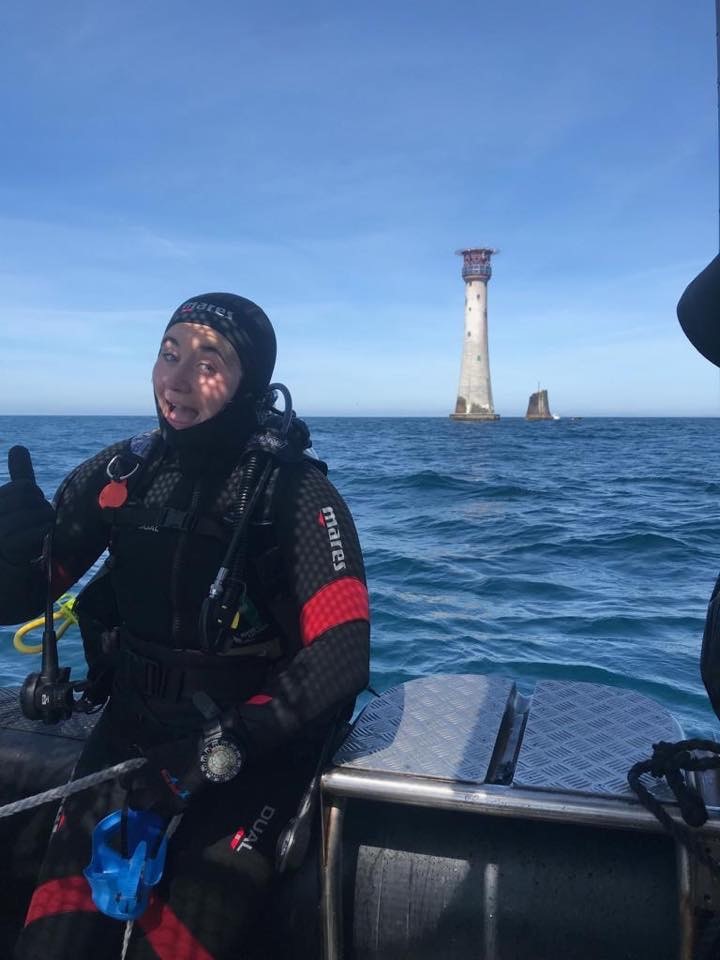
Image caption: Bryony pictured out scuba diving by the Eddystone lighthouse, Plymouth.
She next describes what her work involves, and how it supports teams and projects her at the laboratory.
“At the moment, I am busy manually identifying phytoplankton images taken by our Imaging Flow Cytobot (IFCB). We are building up a library of annotated images, of all different kinds of phytoplankton, with a view to automating the image identification process for high frequency sampling when we deploy the IFCB in situ at our L4 monitoring station.”
Bryony’s work supports APICS (The Automated, in situ Plankton Imaging and Classification System project), with technology like the IFCB a key part of the project. The IFCB is submersible and will be deployed at our APICS buoy, adjacent to our L4 coastal station (6 nautical miles south of Plymouth), offering advanced monitoring of plankton in-situ – automatically generating high-resolution images directly from the site. As it will be extracting data continuously, it will also collect a higher range and frequency of data than could ever possibly be collected manually by a person or team of people.
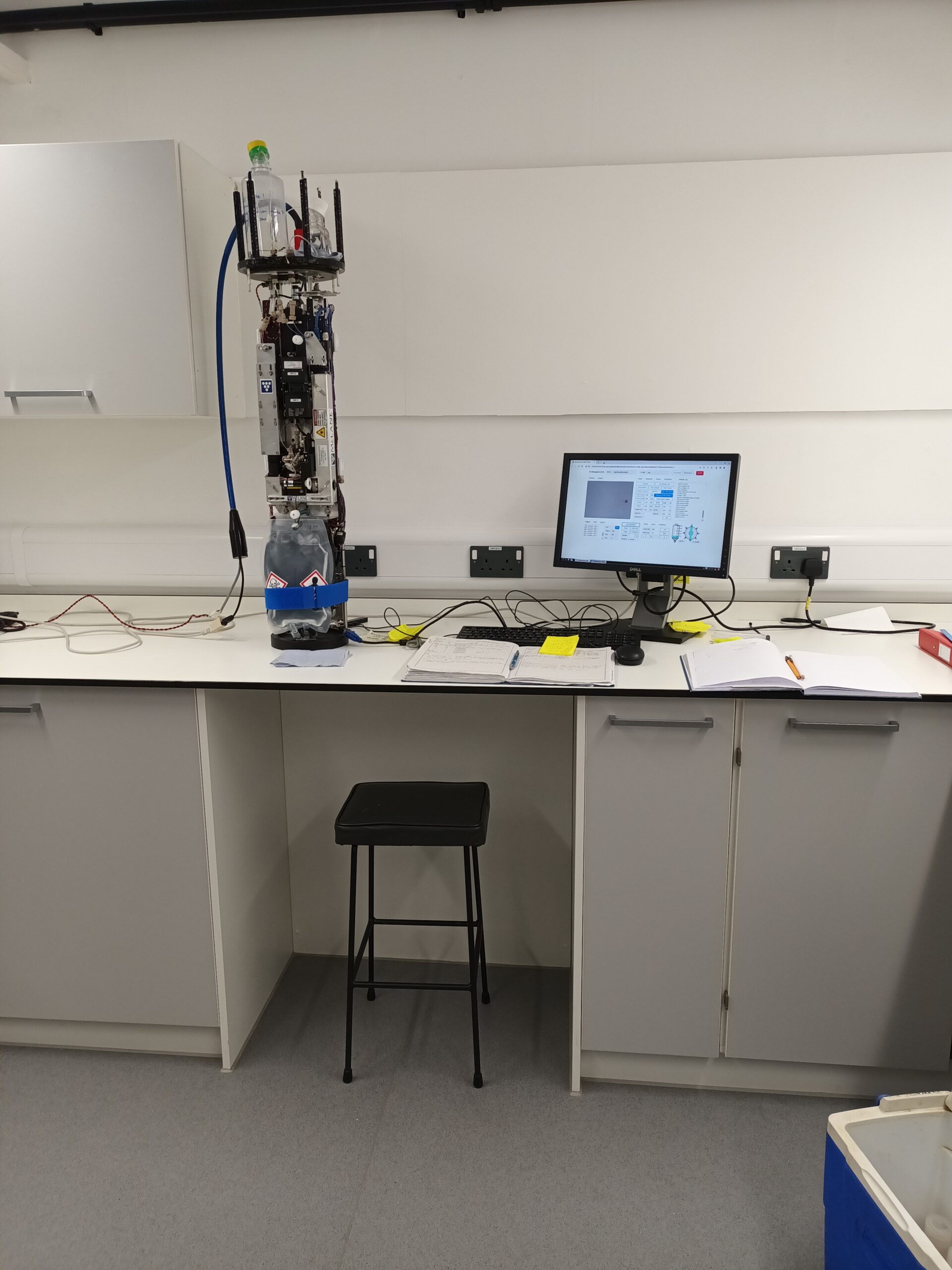
Image above: The Imaging-Flow Cytobot, for automatic imaging and classification of plankton that range in size from <10 μm to 150 μm
Bryony continues:
“The data collected by the IFCB will also be used for our own phytoplankton research to enhance the L4 plankton time-series, and will also contribute towards the DEAL project, where we will be joining forces with other marine imaging instrument users.”
DEAL (DEcentrAlised Learning for automated image analysis and biodiversity monitoring) will develop software systems and Artificial Intelligence (AI) to improve biodiversity monitoring by automating the analysis of plankton and sea floor image data.
“We had the first DEAL stakeholder workshop a couple of weeks ago, it was really interesting to be involved and learn more about the direction and aims of this project.”
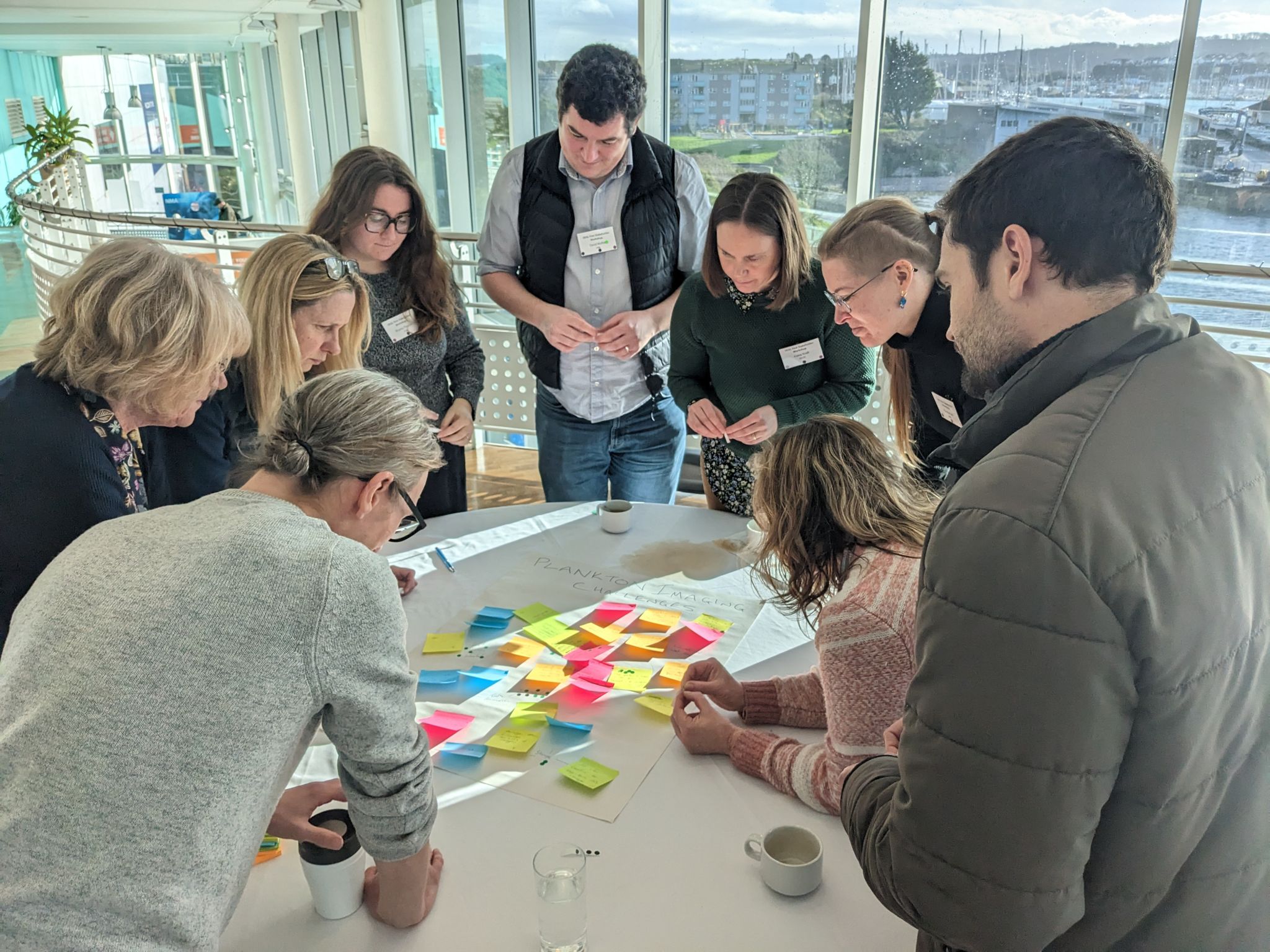
Image caption: Bryony with the team at a DEAL stakeholder meeting, held at the National Marine Aquarium.
Bryony continues to describe other areas of work at the laboratory:
“I also analyze the 20 micron [1 micron is just 0.001 mm, so this is a microscopic measurement!] net samples taken from L4 and E1, this gives us a vital overview of the species composition in Plymouth sound and contributes to the long running and world renowned L4 time series. I am also kept busy by the IFCB itself, along with my lovely colleague/supervisor Claire Widdicombe, we are constantly learning, making changes, maintaining and cleaning the instrument to try and get the highest quality images and information from it.”
“I am also a deputy lab manager in one of the microscopy labs, so I am undertaking some training for that role.”
Bryony describes some highlights from her apprenticeship so far.
“I really love the people I work with, PML is very welcoming. I also can’t quite believe that I get to work with phytoplankton every day of the week, that in itself is very exciting. A recent highlight has been the DEAL workshop at the National Marine aquarium a couple of weeks ago. It was great to be able to meet people involved in a very exciting project, share ideas and little quirks about all the different instruments used within the group. I learnt so much from just a couple of days talking to people.”
“I also recently did some outreach at a primary school near to where I live, for “World of work week” last week. It was a really special afternoon, talking to the students about what I do at PML, spreading the word about how fascinating phytoplankton are and hearing some of their brilliant questions about marine science. I’ve had a few emails from the Head teacher since, telling me all the students won’t stop talking about plankton, which is amazing!”
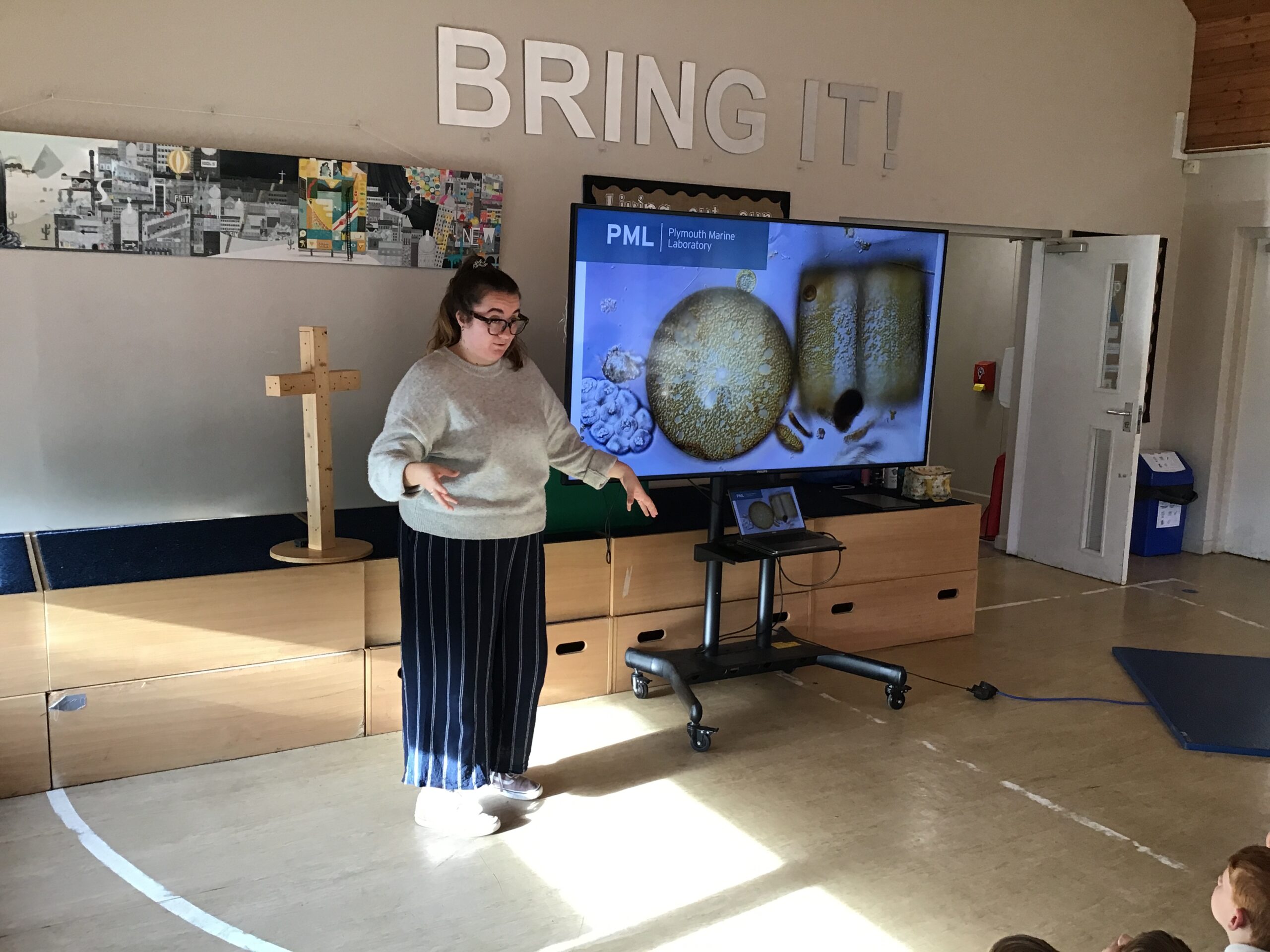
Image caption: Bryony talking to students at her local primary school about Phytoplankton
Bryony describes how long it will take to complete the apprenticeship at PML, and shares her hopes for the future.
“The apprenticeship is a 3-year technical science foundation degree at City College Plymouth. It builds on a lot of technical skills that I am developing within my PML role, and skills I already have from my previous degree. I hope to gain some extra training and skills that will all be very useful with my work here. At the moment I am doing some practical work in some different labs within the college, I would also really like to boost my confidence and practice some presentation skills too. All things that will prove to be very useful for developing my work at PML.”
“I really hope to continue working with phytoplankton at PML! I hope I can develop my skills and gain experience in all aspects of sampling, data processing and dissemination. I would love to continue to contribute to projects, continue to spend lots of time at the microscope and hopefully complete my time as an apprentice to be a fully-fledged member of the PML team.”
Bryony’s supervisor at PML, Claire Widdicombe – Senior Plankton Ecologist and Western Channel Observatory Lead – said:
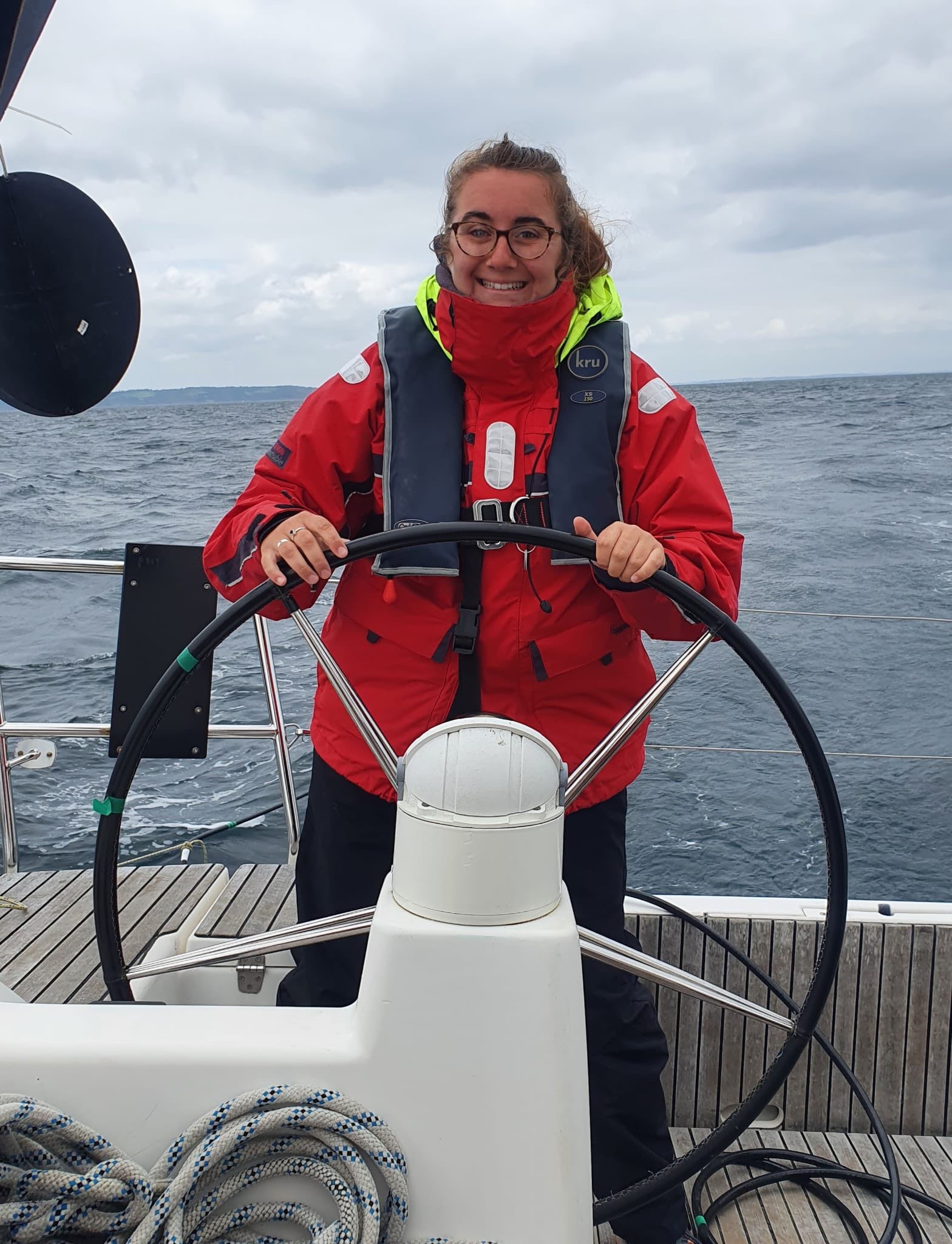
Image above: Bryony out sailing on the ‘Take the Helm’ marine mammal cruise around Cornwall with the Marine Vertebrates Research group at Plymouth University.
A huge thank you Bryony for taking the time to talk to us today!
You can follow Bryony on her Instagram page: MarineBryology2
Related information
Background: National Apprenticeship Week 2025: 10TH – 16TH FEBRUARY 2025
A week-long celebration that brings together businesses and apprentices across the country to shine a light on the positive impact that apprenticeships make to individuals, businesses and the wider economy.
NAW 2025 encourages everyone to consider and celebrate how apprenticeships and skills help individuals develop rewarding careers, and employers to develop a workforce with future-ready skills. Together we will inspire the nation with engaging stories of apprentice and learner progression – sharing their increased confidence, skills, knowledge and how such programmes have kick-started incredible careers.